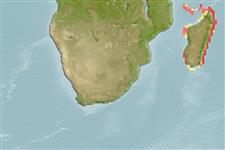>
Eupercaria/misc (Various families in series Eupercaria) >
Sciaenidae (Drums or croakers)
Etymology: Argyrosomus: Greek, argyros = silvered, silver + Greek, soma = body (Ref. 45335).
More on author: Lacepède.
Environment: milieu / climate zone / depth range / distribution range
Écologie
marin; eau douce; saumâtre démersal; profondeur ? - 400 m (Ref. 27121), usually 15 - 150 m (Ref. 27121). Subtropical; 13°C - 24°C (Ref. 3593); 11°N - 27°S, 43°E - 51°E
Indian Ocean: endemic to Madagascar (Ref. 11025). Reports from "Ghana to South Africa" (Ref. 57396) refer to Argyrosomus regius and Argyrosomus coronus (Ref. 11025).
Taille / Poids / Âge
Maturity: Lm ? range ? - ? cm
Max length : 200 cm TL mâle / non sexé; (Ref. 4336); common length : 100.0 cm SL mâle / non sexé; (Ref. 9772); poids max. publié: 71.0 kg (Ref. 5369); âge max. reporté: 30 années (Ref. 12198)
Épines dorsales (Total) : 11; Rayons mous dorsaux (Total) : 26 - 30; Épines anales: 2; Rayons mous anaux: 7. Body silvery; fins grey or brown; upper end of pectoral base with a black blotch (Ref. 4373).
Found in lower reaches of rivers, estuaries, rocky reefs, ocean beaches and on the continental shelf down to 150 m (Ref. 9772). Caught near the bottom and in mid-water. Feed mainly at night or in turbid waters (Ref. 27121), preying on cuttlefish (Ref. 27121), fishes, crabs, prawns, and worms (Ref. 9772).
Life cycle and mating behavior
Maturities | Reproduction | Spawnings | Egg(s) | Fecundities | Larves
Chao, L.N. and E. Trewavas, 1990. Sciaenidae. p. 813-826. In J.C. Quero, J.C. Hureau, C. Karrer, A. Post and L. Saldanha (eds.) Check-list of the fishes the eastern tropical Atlantic (CLOFETA). JNICT, Lisbon; SEI, Paris; and UNESCO, Paris. Vol. 2. (Ref. 3593)
Statut dans la liste rouge de l'IUCN (Ref. 130435)
Menace pour l'homme
Harmless
Utilisations par l'homme
Pêcheries: commercial; pêche sportive: oui
Outils
Articles particuliers
Télécharger en XML
Sources Internet
Estimates based on models
Preferred temperature (Ref.
123201): 21.4 - 27.6, mean 25.9 °C (based on 60 cells).
Phylogenetic diversity index (Ref.
82804): PD
50 = 0.5020 [Uniqueness, from 0.5 = low to 2.0 = high].
Bayesian length-weight: a=0.00562 (0.00332 - 0.00953), b=3.06 (2.92 - 3.20), in cm total length, based on LWR estimates for this species & (Sub)family-body (Ref.
93245).
Niveau trophique (Ref.
69278): 4.5 ±0.8 se; based on diet studies.
Résilience (Ref.
120179): Très faible, temps minimum de doublement de population supérieur à 14 ans (K=0.03; tm=6).
Fishing Vulnerability (Ref.
59153): Very high vulnerability (90 of 100).
Climate Vulnerability (Ref.
125649): Moderate to high vulnerability (53 of 100).
Nutrients (Ref.
124155): Calcium = 25.3 [8.9, 63.9] mg/100g; Iron = 0.471 [0.168, 1.367] mg/100g; Protein = 20.1 [18.2, 22.0] %; Omega3 = 0.355 [0.203, 0.580] g/100g; Selenium = 32 [11, 105] μg/100g; VitaminA = 6.51 [2.03, 22.25] μg/100g; Zinc = 0.481 [0.343, 0.711] mg/100g (wet weight); based on
nutrient studies.
